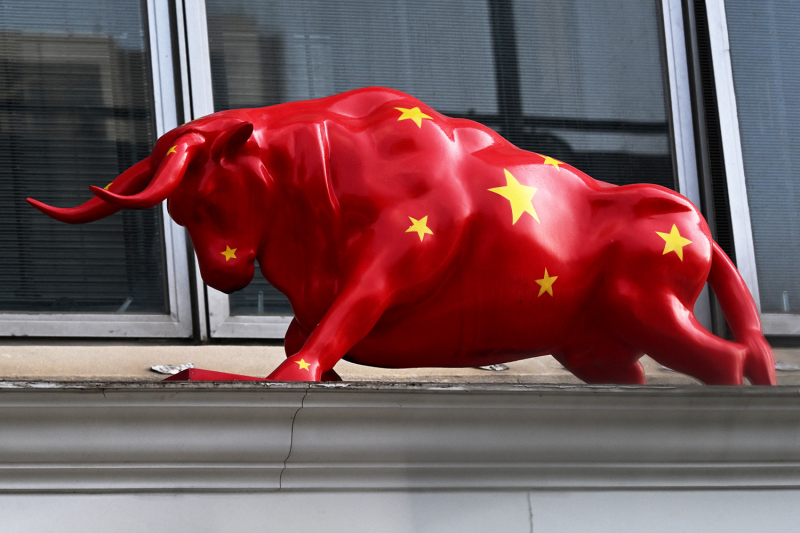How China Should Handle Trump’s Tariffs

How China Should Handle Trump’s Tariffs
Tit-for-tat fights are a dead end.
A sculpture of a bull decorated in the Chinese flag is seen above a securities exchange in Hong Kong on April 9. Peter Parks/AFP via Getty Images
China fired back at the Trump administration’s tariff hike, raising duties on U.S. goods to 84 percent—a dramatic increase from the previous 34 percent. The move came just hours after the U.S. imposed its own sweeping increases, bringing total tariffs on Chinese imports to over 100 percent, and was followed with a declaration by U.S. President Donald Trump of 125 percent tariffs today. For Beijing, the political message is unambiguous: The United States is weaponizing trade beyond the realm of economic rationality.
China’s knee-jerk response has been to meet Trump’s threats with resounding resolve and retaliatory tariffs: Official statements and state media editorials insist that the country possesses “sufficient tools” and “full confidence” to respond. But that instinct—while emotionally satisfying—is a strategic misstep.
China fired back at the Trump administration’s tariff hike, raising duties on U.S. goods to 84 percent—a dramatic increase from the previous 34 percent. The move came just hours after the U.S. imposed its own sweeping increases, bringing total tariffs on Chinese imports to over 100 percent, and was followed with a declaration by U.S. President Donald Trump of 125 percent tariffs today. For Beijing, the political message is unambiguous: The United States is weaponizing trade beyond the realm of economic rationality.
China’s knee-jerk response has been to meet Trump’s threats with resounding resolve and retaliatory tariffs: Official statements and state media editorials insist that the country possesses “sufficient tools” and “full confidence” to respond. But that instinct—while emotionally satisfying—is a strategic misstep.
Tit-for-tat tariffs may appease nationalist sentiment, but they lock China into a spiral where the structural asymmetry of trade plays to Washington’s advantage. With a persistent bilateral surplus, China eventually runs out of American goods to penalize. Beijing has tried to broaden its toolkit—imposing export controls on rare earths, ramping up scrutiny of U.S. companies, and delaying customs clearances—but such tools come with collateral damage. They spook investors, rattle supply chains, and alienate potential allies.
The deeper risk is that non-tariff retaliation—especially possible moves targeting American firms operating in China or blocking agricultural imports—will further dent foreign investor confidence. At a moment when Beijing is trying to court capital and stabilize markets, these tactics are self-defeating.
If China wants to disarm the trade-war narrative, it needs to do something far bolder: flip the script.
First, Beijing must accelerate trade and investment deals with key neighbors and partners—not just in rhetoric, but with visible, sustained follow-through. This means breaking the logjam on the long-stalled China-Japan-South Korea Free Trade Agreement, strengthening implementation of the Regional Comprehensive Economic Partnership (RCEP), and reenergizing dialogue with the European Union.
While some of these efforts have surfaced in recent weeks, they remain only a starting point. While European concerns over industrial overcapacity, state support, and China’s alignment with Russia persist, this moment offers a rare opening to reset. Beijing might also consider revisiting discussions around joining the Comprehensive and Progressive Agreement for Trans-Pacific Partnership (CPTPP)—a signal of serious intent to reintegrate into global trade frameworks and reassure skeptical partners. Europe is increasingly anxious that the latest U.S. tariff assaults will deflect Chinese exports toward their markets. The concern is real: If the U.S. closes its doors, Chinese goods may flood elsewhere, fueling protectionist backlash. Without a proactive shift, the EU could soon follow Washington’s lead with tariffs of its own.
China’s relationship with Southeast Asia is also under pressure. Offshoring to the region once helped Chinese exporters sidestep tariffs, but Trump’s latest actions—hitting, among others, Vietnamese exports with heavy duties—highlight the limits of that workaround. If the U.S. cracks down on transshipment, the smarter path is to build durable, rules-based partnerships with the Association of Southeast Asian Nations, not just route trade through it.
China’s ties with Japan, South Korea, India, and the Philippines remain tense. Historical grievances, territorial disputes, and worries about economic coercion have taken a toll. In 2024 and early 2025, Japan lodged formal protests over repeated incursions by Chinese coast guard vessels near the disputed Senkaku/Diaoyu Islands. India remains wary of China’s continued infrastructure buildup along contested stretches of the Himalayan border, including areas near Arunachal Pradesh and Ladakh. South Korean firms have reported growing unease over regulatory unpredictability in China—an undercurrent made more acute by deepening U.S.-South Korea military cooperation and lingering memories of the 2016-2017 THAAD backlash.
Meanwhile, tensions with the Philippines escalated in 2024, with multiple confrontations in the South China Sea, including the use of water cannons and lasers against resupply missions to Second Thomas Shoal, prompting formal protests from Manila. Beijing’s assertive posture—at sea, along borders, and through informal economic levers—has compounded regional mistrust. But shared uncertainty about U.S. reliability leaves room to rebuild trust. A regional reset—grounded in genuine economic cooperation—could help China shift its image from disruptive power to regional anchor.
China should also rebrand itself as the guardian of global trade—especially for developing economies. This demands concrete steps: unilaterally slashing tariffs for non-U.S. partners, eliminating investment bottlenecks, and visibly championing trade liberalization.
In doing so, Beijing could claim the mantle that Washington has dropped: defender of an open, rules-based global economy. While the U.S. doubles down on protectionism, China can fill the vacuum by offering a credible, stable alternative.
This would also include easing non-tariff barriers for Latin America, Africa, and South Asia—regions whose political and economic stability often hinge on robust export demand. While China has granted partial tariff exemptions to select least-developed countries, broad access remains constrained.
Exporters frequently face import licensing hurdles, quota ceilings—especially on agricultural products—and inconsistent sanitary and phytosanitary standards that are costly to navigate. In sensitive sectors such as critical infrastructure and media, barriers are unlikely to completely lift anytime soon due to national security and ideological concerns. But beyond those areas, there is room for meaningful liberalization. Expanding duty-free programs, streamlining logistics, and improving access to Chinese markets and capital flows would show substance beyond slogans. The technical blueprint exists. What’s needed is political will.
None of this external rebalancing will succeed unless China addresses its most chronic internal challenge: weak household consumption. For over a decade, Beijing has pledged to shift toward a consumption-led economy. Progress has been halting at best. Household spending remains depressed, income inequality endures, and social safety nets are too fragile to encourage real spending. COVID insecurities have made households even more risk-averse.
But the tools are on the table. Xi has promised to “unleash” consumption in response to Trump’s tariffs. Behind closed doors, senior officials are reportedly debating fast-tracking long-standing proposals: targeted subsidies for home appliances and electric vehicles, rural income support, and a national real estate stabilization fund. These policies could roll out in phases, with the pace adjusted based on market sentiment and geopolitical developments.
Scale and credibility will matter. Rebuilding domestic demand isn’t just a policy choice—it’s an existential necessity. China’s global export share cannot keep rising without triggering backlash. The only sustainable growth engine is the Chinese household.
One target being floated by Chinese analysts and strategists: raise domestic consumption by 30 percent by 2030—roughly $3 trillion in additional annual demand. That could, in theory, offset the loss of U.S. market access and generate a new gravitational center for global trade. But to achieve it, Beijing must act with urgency.
That means expanding social welfare programs, accelerating hukou reforms to integrate migrant workers into cities, improving access to public health care and education, and constructing a more redistributive fiscal architecture. These are ambitious but achievable goals—and they are China’s best bet for resilience.
This trade shock is not a routine policy challenge. Analysts have likened its disruptive potential to the 2008 global financial crisis or the COVID crash of 2020. Financial markets are unlikely to wait for Beijing’s usual policy cycle to kick in. That’s why recent signs of urgency—from early stimulus rumors to a narrative shift toward consumption—deserve attention.
Compared to Washington, Beijing still enjoys greater policy latitude. Asset prices are lower, inflation is subdued, and the political system allows for coordinated action. If it can front-load stimulus, reassure households, and prove policy consistency, China might navigate the turbulence more nimbly than its rivals.
A last radical idea: keep talking to Washington. The true projection of strength is not isolation but engagement. Don’t walk away from cooperation on fentanyl, AI governance, or climate. These are global challenges that demand global leadership.
And mature leadership means staying in the game even when the other side is trying to upend the board. Beijing must present itself as a constructive and consistent partner on global issues—even as Washington turns inward.
The real danger is that Beijing remains boxed into a reactive posture, shadowboxing its way through a game it didn’t design. Escalation is easy. Strategy is harder. Retaliation is not sustainable. Winning a shouting match isn’t winning the game. Beijing must define the rules of engagement. That means anchoring new global trade coalitions, accelerating long-overdue reforms, and presenting a credible alternative to U.S.-led economic nationalism. This is not a moment to retaliate. It’s a moment to redefine the board—and lead.
Lizzi C. Lee is a fellow on Chinese economy at the Asia Society Policy Institute’s Center for China Analysis.
More from Foreign Policy
-

American flags are draped around tables and pipes in a small factory room as women work at sewing machines to produce them. Tariffs Can Actually Work—if Only Trump Understood How
Smart trade policy could help restore jobs, but the president’s carpet-bomb approach portends disaster.
-

Donald Trump looks up as he sits beside China’s President Xi Jinping during a tour of the Forbidden City in Beijing on Nov. 8, 2017. Asia Is Getting Dangerously Unbalanced
The Trump administration continues to create headlines, but the real story may be elsewhere.
-

Trump announces tariffs Trump’s Wanton Tariffs Will Shatter the World Economy
Economic warfare is also a test for U.S. democracy.
-

The Department of Education building in Washington, DC on March 24. Why Republicans Hate the Education Department
Broad popular support means that even Ronald Reagan failed at dismantling the agency.









Join the Conversation
Commenting on this and other recent articles is just one benefit of a Foreign Policy subscription.
Already a subscriber?
.
Subscribe
Subscribe
View Comments
Join the Conversation
Join the conversation on this and other recent Foreign Policy articles when you subscribe now.
Subscribe
Subscribe
Not your account?
View Comments
Join the Conversation
Please follow our comment guidelines, stay on topic, and be civil, courteous, and respectful of others’ beliefs.
Change your username |
Log out
Change your username:
CANCEL
Confirm your username to get started.
The default username below has been generated using the first name and last initial on your FP subscriber account. Usernames may be updated at any time and must not contain inappropriate or offensive language.